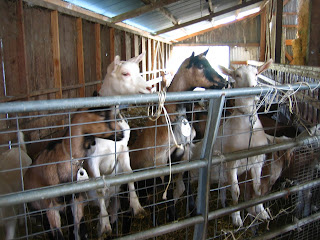 |
| Whiney Lars wearing his green chalk |
Here at Toluma Farms, the fall breeding season is wrapping up. Like sheep, goats naturally breed as the days get shorter. The females go into heat every 21 days for about 24 hours. You can usually tell who is in heat because they wag their tails, are more vocal and will hang out next to the male goats. The male goats that are used for breeding are called bucks. Bucks come into rut when the does are in heat, which is displayed by curling their upper lip, flapping their tongues and -brace yourself- urinating all over themselves. This creates a pungent goaty musk that the doe's find irresistible; thus breeding commences.
At Toluma we have five bucks of different breeds used for different purposes. A single buck can impregnate a lot of doe's and consequently provides half the genetics of a herd (the other half provided by each doe). Choosing bucks with traits that will benefit your herd (such as coming from milky mothers with quality teats and good parasite resistance), is very important.
So without further ado - the Toluma Farms buck lineup!
Lars (pictured above) is experiencing his first breeding season and by all appearances is doing a great job. He is Saanen buck and currently ranked the #1 Saanen buck on the American Dairy Goat Association Young Sire list (a statistical ranking for bucks that haven't sired any babies yet). Lars is wearing a harness with green chalk on it which helps us keep track of who he is breeding. When he is doing his job well, there should be lots of chalked up doe's.
 |
| The does get chalked when the buck breeds them |
 |
| Sting |
Sting is a big Alpine buck who looks kind of scary but is actually a pretty sweet guy, when he is not trying to rub is goat musk on you. He is the father of many of our good milkers.
 |
| Kazeem the Lamancha |
 |
| Neptune the Lamancha |
Kazeem and Neptune are Lamancha goats and despite their European sounding name, this minimally eared breed was developed in Oregon. These two bucks will likely be used to breed the yearling does (that were born early 2011) as they tend to sire small babies - with the intent to give the first time mothers an easy kidding experience.
 |
| Fred the boer |
Fred is a boer goat, which are generally used for meat and are quite a bit smaller than the milking goats. Eric, the farm manager, was interested in having some multipurpose goats by breeding Fred to some doe's but truthfully, Fred was more interested in eating than the ladies this year.
The first babies are due January 7th and the kidding storm will continue on into April. We offer public tours the first Sunday of every month, starting in January...come check out the farm!

















